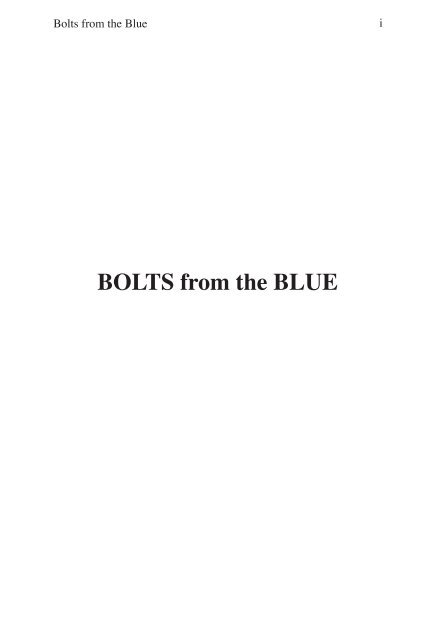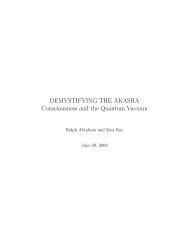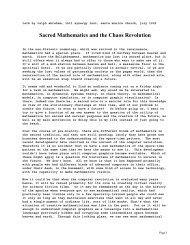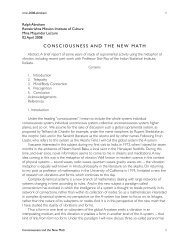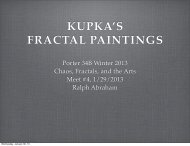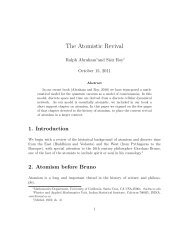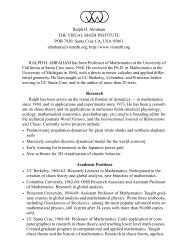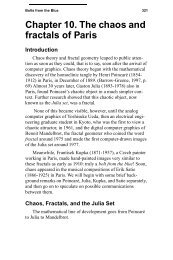BOLTS from the BLUE - Ralph Abraham
BOLTS from the BLUE - Ralph Abraham
BOLTS from the BLUE - Ralph Abraham
Create successful ePaper yourself
Turn your PDF publications into a flip-book with our unique Google optimized e-Paper software.
Bolts <strong>from</strong> <strong>the</strong> Blue<br />
i<br />
<strong>BOLTS</strong> <strong>from</strong> <strong>the</strong> <strong>BLUE</strong>
ii<br />
Bolts <strong>from</strong> <strong>the</strong> Blue<br />
Also by <strong>Ralph</strong> Herman <strong>Abraham</strong><br />
• Foundations of Mechanics<br />
(with Jerrold Marsden)<br />
• Manifolds, Tensors, and Applications<br />
(with Jerrold Marsden and Tudor Ratiu)<br />
• Dynamics, <strong>the</strong> Geometry of Behavior<br />
(with Christopher Shaw)<br />
• Chaos, Gaia, Eros<br />
• Chaos in Discrete Dynamical Systems<br />
(with Laura Gardini and Christian Mira)<br />
• Chaos, Creativity, and Cosmic Consciousness<br />
(with Terence McKenna and Rupert Sheldrake)<br />
• The Evolutionary Mind<br />
(with Terence McKenna and Rupert Sheldrake)<br />
• The Chaos Avant-garde<br />
(with Yoshisuke Ueda)<br />
• Demystifying <strong>the</strong> Akasha<br />
(with Sisir Roy)
Bolts <strong>from</strong> <strong>the</strong> Blue<br />
iii<br />
<strong>BOLTS</strong> <strong>from</strong> <strong>the</strong> <strong>BLUE</strong><br />
Art, Ma<strong>the</strong>matics, and Cultural Evolution<br />
<strong>Ralph</strong> Herman <strong>Abraham</strong><br />
Epigraph Books<br />
Rhinebeck, New York
iv<br />
Bolts <strong>from</strong> <strong>the</strong> Blue<br />
Bolts <strong>from</strong> <strong>the</strong> Blue: Art, Ma<strong>the</strong>matics, and Cultural Evolution.<br />
Copyright c 2010 by <strong>Ralph</strong> <strong>Abraham</strong>. All rights reserved.<br />
No part of this book may be used or reproduced in any manner<br />
without written permission <strong>from</strong> <strong>the</strong> publisher except in critical<br />
articles and reviews. For information contact:<br />
Epigraph Publishing Service<br />
27 Lamoree Road<br />
Rhinebeck, New York 12572<br />
Printed in <strong>the</strong> United States of America<br />
Library of Congress Catalogue-in-Publication Data<br />
<strong>Abraham</strong>, <strong>Ralph</strong><br />
Bolts <strong>from</strong> <strong>the</strong> Blue: Art, Ma<strong>the</strong>matics, and Cultural<br />
Evolution by <strong>Ralph</strong> <strong>Abraham</strong>.<br />
xvi + 126 pp.<br />
ISBN xxxx<br />
Six bolts <strong>from</strong> <strong>the</strong> blue – 1936.<br />
Library of Congress Control Number: xxxx<br />
Bulk purchase discounts for educational or promotional purposes<br />
are available. Contact <strong>the</strong> publisher for more information.<br />
Epigraph Publishing Service<br />
27 Lamoree Road<br />
Rhinebeck, New York 12572<br />
www.monkfishpublishing.com
Bolts <strong>from</strong> <strong>the</strong> Blue<br />
v<br />
Dedicated to <strong>the</strong> late:<br />
Andra Akers<br />
Terence McKenna<br />
Nina Graboi
vi<br />
Bolts <strong>from</strong> <strong>the</strong> Blue
Bolts <strong>from</strong> <strong>the</strong> Blue<br />
vii<br />
FOREWORD<br />
by<br />
William Irwin Thompson<br />
The End of <strong>the</strong> Age of Religion and<br />
<strong>the</strong> Birth of Symbiotic Consciousness 1<br />
Through my collaboration with <strong>the</strong> chaos ma<strong>the</strong>matician<br />
<strong>Ralph</strong> <strong>Abraham</strong> in designing an evolution of consciousness curriculum<br />
for <strong>the</strong> Ross School in East Hampton, New York, I began to understand<br />
that <strong>the</strong> shift <strong>from</strong> <strong>the</strong> linear causation of Galilean dynamics<br />
in <strong>the</strong> early modern era to <strong>the</strong> complex dynamical systems of our era<br />
also expressed a shift <strong>from</strong> linear modernist ideologies and religions<br />
to planetary ecologies of consciousness in which diversity was affirmed.<br />
In <strong>the</strong> evolution of <strong>the</strong> catastrophe <strong>the</strong>ory of <strong>the</strong> 1960s—with<br />
<strong>the</strong>ir images of saddles and butterfly folds—to <strong>the</strong> images of fractals<br />
and Lorenz attractors in <strong>the</strong> chaos dynamics of <strong>the</strong> 1980s, our cultural<br />
Imaginary was given a gift of a new alphabet of symbols. Dynamical<br />
systems were given geometrical portraits of <strong>the</strong>ir behavior, and<br />
<strong>the</strong>se were <strong>the</strong>refore called phase portraits. 2 The linearity of leftbrain<br />
thinking was now to be balanced with a right-brain activation.<br />
This emergence of a new visual ma<strong>the</strong>matics expressed, in effect, a<br />
return on a higher turn of <strong>the</strong> spiral to hieroglyphic thinking.<br />
It all started with Poincaré in Paris in 1889 when he showed<br />
that <strong>the</strong> clean and consistent system of Kepler in which <strong>the</strong> planets<br />
rotated around <strong>the</strong> sun in neat ellipses was not correct, that <strong>the</strong><br />
solar system was actually a chaotic system. You can date <strong>the</strong> birth of<br />
complex dynamical systems with Poincaré and say that <strong>the</strong> new era<br />
begins with his ma<strong>the</strong>matical revisioning of <strong>the</strong> geometry of behavior<br />
of <strong>the</strong> solar system. At about this time <strong>the</strong> premodernist esoteric<br />
cosmologies began to experience what Marshall McLuhan called<br />
1 Reprinted <strong>from</strong> Seven Pillars House of Wisdom.<br />
2 (<strong>Abraham</strong>, 1999)
viii<br />
Bolts <strong>from</strong> <strong>the</strong> Blue<br />
“cultural retrieval,” and thinkers like Rudolf Steiner, Hazrat Inayat<br />
Khan and William Butler Yeats began <strong>the</strong>ir visionary careers. The<br />
linear reductionism of modernism was going to be challenged by a<br />
cultural retrieval of animism on one side and higher ma<strong>the</strong>matics on<br />
<strong>the</strong> o<strong>the</strong>r. The composer Satie was a Rosicrucian, and <strong>the</strong> painters<br />
Kandinsky and Mondrian were Theosophists. Clearly, complex dynamical<br />
systems began to impact on <strong>the</strong> cultural evolution of human<br />
spirituality.<br />
What could this new planetary culture possibly look like?<br />
First, egocentric monumentality and <strong>the</strong> extensive clutter of industrial<br />
civilization could be eliminated. We could shift <strong>from</strong> industrial<br />
object to ecological process—as foreshadowed in <strong>the</strong> “Living Machines”<br />
of John Todd. 3 Some buildings through <strong>the</strong> effectiveness of<br />
nanotechnologies could become ephemeral and evanescent; enduring<br />
structures could be more ecologically embedded in <strong>the</strong>ir setting—like<br />
<strong>the</strong> Shire of <strong>the</strong> Hobbits in <strong>the</strong> writings of Tolkien. We<br />
could become electronic nomads who pitch <strong>the</strong>ir tent, and <strong>the</strong>n pack<br />
up and move on. Buildings could become appliances that we turn on<br />
with a switch, and <strong>the</strong>n turn off to make <strong>the</strong>m disappear in <strong>the</strong> forest<br />
or meadow, and this would enable <strong>the</strong> human and animal domains<br />
to coexist more peaceably. Think of this as an electronic version of<br />
<strong>the</strong> Arthurian Lady of <strong>the</strong> Lake who used enchantment to keep her<br />
settlement hidden to mortals so that it appeared to <strong>the</strong> local inhabitants<br />
only as a lake.<br />
Our machines could become intimate and ensouled by <strong>the</strong><br />
elemental beings whose presence we might rediscover in <strong>the</strong> coming<br />
period of intense volcanic and tectonic activity. We will all have<br />
a chance to become animists again—like <strong>the</strong> present population of<br />
Iceland or <strong>the</strong> kahunas of Polynesia—those people who have been<br />
living with volcanoes for some time. The kind of being that once<br />
was envisioned as ensouling a sacred mountain could now be seen to<br />
ensoul <strong>the</strong> noetic lattice of crystals in electronic and quantum computers<br />
in a new cultural Imaginary. As <strong>the</strong>se computers are worn on<br />
and in our bodies and our body-politic, our sense of “in here” and<br />
“out <strong>the</strong>re” would be transformed as a cube became a tesseract or a<br />
sphere became a spiraling hypertorus in which <strong>the</strong> inside and outside<br />
3 (Todd, 1994)
Bolts <strong>from</strong> <strong>the</strong> Blue<br />
ix<br />
surface are continuous through <strong>the</strong> spiraling axis.<br />
Our consciousness could become symbiotic, as elementals<br />
become to us what mitochondria are to nucleated cells. But this<br />
symbiotic consciousness need not simply be restricted to human and<br />
elemental or animal realms, it could also be extended to involve <strong>the</strong><br />
celestial intelligences. To imagine <strong>the</strong>se “software” beings that are<br />
made out of music and ma<strong>the</strong>matics, we need once again to go back<br />
to <strong>the</strong> end of <strong>the</strong> film 2001: A Space Odyssey (which I discussed<br />
with Arthur C. Clarke over breakfast in New York long ago in 1971).<br />
When <strong>the</strong> astronaut approaches <strong>the</strong> monolith in orbit over Jupiter, he<br />
sees coming toward him rotating crystals of light and complex pulsing<br />
topologies. These are Stanley Kubrick’s technological envisioning<br />
of what esoteric initiates would recognize to be <strong>the</strong> Neoplatonic<br />
”celestial intelligences”—<strong>the</strong> Jinn of <strong>the</strong> Moon and <strong>the</strong> Angels and<br />
Archangels of <strong>the</strong> planets and stars. For Kubrick’s and Clarke’s vision,<br />
however, it is <strong>the</strong>se high tech cosmic beings who serve as midwives<br />
to <strong>the</strong> astronaut’s rebirth as he moves out of history into myth.<br />
To draw a circle one moves <strong>from</strong> <strong>the</strong> point to <strong>the</strong> line; to<br />
draw a sphere, one pulls <strong>the</strong> circle up into <strong>the</strong> third dimension; to<br />
create a hypersphere, one rotates <strong>the</strong> sphere into <strong>the</strong> fourth dimension.<br />
Our physical body, or what <strong>the</strong> yogis call our food sheath, has<br />
three dimensions, but our o<strong>the</strong>r bodies or sheaths have more dimensions,<br />
and it is in <strong>the</strong> facets of <strong>the</strong> topology of <strong>the</strong>se dimensions that<br />
<strong>the</strong> celestial intelligences can interface with us and participate in <strong>the</strong><br />
field of our consciousness. The brain may be a three-dimensional<br />
volume, but neurons in separate parts of <strong>the</strong> brain can fire toge<strong>the</strong>r<br />
in <strong>the</strong> neuronal synchrony of <strong>the</strong> range of 40 Hertz. The geometry of<br />
<strong>the</strong> synchronies engage as facets of <strong>the</strong> higher-dimensional geometries<br />
of <strong>the</strong> subtle bodies—where both <strong>the</strong> Dalai Lama and Rudolf<br />
Steiner say memory is stored—so <strong>the</strong> play of consciousness should<br />
not simply be reduced to a section of <strong>the</strong> brain. 4 Cultures have in <strong>the</strong><br />
past called this process of consciousness, imagination or intuition,<br />
but whatever one calls it, it is basic to <strong>the</strong> creative process in art, science<br />
and spiritual contemplative practice.<br />
Mediating between <strong>the</strong> elemental and human on one polarity<br />
and <strong>the</strong> celestial intelligences on <strong>the</strong> o<strong>the</strong>r is <strong>the</strong> realm of <strong>the</strong><br />
4 (Varela, 1997; p. 174)
x<br />
Bolts <strong>from</strong> <strong>the</strong> Blue<br />
soul, which for men is often figured as a feminine being—a Tara or<br />
Beatrice. (Jung maintained that for women this contrasexual “animus”<br />
was male—<strong>the</strong> Christ of Saint Teresa of Avila or <strong>the</strong> Krishna of<br />
Mirabai.) This being appears regularly in <strong>the</strong> intermediate life of our<br />
dreams—and here one needs to understand that dreams, as Sri Aurobindo<br />
pointed out for his generation, are very muddled memories<br />
of higher spiritual experiences blended with <strong>the</strong> proprioperceptions<br />
of <strong>the</strong> physical body and <strong>the</strong> brain’s return to waking consciousness.<br />
As <strong>the</strong> spirit returns to <strong>the</strong> confinements of incarnation, it can start to<br />
dream it is in a conference, or a crowded airport, and as it becomes<br />
aware of <strong>the</strong> body’s full bladder, it will begin to dream that it is looking<br />
for <strong>the</strong> restroom in <strong>the</strong> airport. To interpret <strong>the</strong>se dreams with<br />
Freudian or Jungian symbolic systems is, at this level, a category<br />
mistake. The imagery is taken <strong>from</strong> personal memory and is being<br />
used as metaphors for <strong>the</strong> reactivation of specific brain modules that<br />
are operative in <strong>the</strong> cognitive functions of <strong>the</strong> waking mind.<br />
Shamanism was <strong>the</strong> form of spirituality that evolved in <strong>the</strong><br />
oral culture of preliterate societies. Religion was <strong>the</strong> form of spirituality<br />
that emerged with literate societies and <strong>the</strong>ir new temple-based<br />
readings of <strong>the</strong> stars and sacred texts. Though traditionalists may<br />
wish time to stop, it does go on, and now in our global electronic<br />
society, a new transreligious form of spirituality is emerging, one<br />
that will not replace religions, anymore than <strong>the</strong> nucleus of <strong>the</strong> cell<br />
replaced <strong>the</strong> mitochondria, but will envelop <strong>the</strong>m in a much vaster<br />
form of consciousness. In this futuristic ontology, we are already<br />
beginning to glimpse an evolutionary Entelechy—a symbiotic consciousness<br />
of human, elemental, psychic and celestial intelligences.<br />
In <strong>the</strong> smuggled esoterism of children’s literature, comic books and<br />
science fiction, an archetypal group of four becoming one is being<br />
foreshadowed. For example, we see this grouping expressed in Fantastic<br />
Four and The Wizard of Oz.<br />
In preindustrial animist cultures, <strong>the</strong> human would establish<br />
a place for <strong>the</strong> elementals to cohabit or participate in its human life<br />
through <strong>the</strong> intermediary use of a magical object—a magical ring<br />
or stone, an Aladdin’s lamp or an ensouled sword such as Roland’s<br />
Durendal or Charlemagne’s Montjoie. Like <strong>the</strong> needles used in acupuncture,<br />
this numinous object can interact with its possessor at <strong>the</strong>
Bolts <strong>from</strong> <strong>the</strong> Blue<br />
xi<br />
subtle-physical or e<strong>the</strong>ric level—<strong>the</strong> level of qi or prana. In shamanistic<br />
cultures, <strong>the</strong> individual would project out of his or her body and<br />
travel in a spiritual or astral world. If one is able through meditation<br />
to remain watchfully awake in <strong>the</strong> state of deep dreamless sleep,<br />
<strong>the</strong>n one experiences a vast magenta sea of cognitive bliss in which<br />
one hears <strong>the</strong> music of everything—every existent being in <strong>the</strong><br />
universe sounding its presence. This is <strong>the</strong> world of <strong>the</strong> Holy Spirit<br />
that is “above” or “below”—remember <strong>the</strong>se terms express a merely<br />
Euclidean geometry—<strong>the</strong> psychic realm of dreams or astral out-of<strong>the</strong>-body<br />
travel. In <strong>the</strong> astral, one travels, but in <strong>the</strong> realm of celestial<br />
music, <strong>the</strong> center is everywhere and <strong>the</strong> circumference nowhere, so<br />
<strong>the</strong>re is no need to move. One simply joins in this Hallelujah Chorus<br />
to <strong>the</strong> nth power by listening and sounding one’s ontic note. In this<br />
sense, music is not a representational art of mimesis, but an ontological<br />
performance.<br />
The human is <strong>the</strong> ordinary ego in time, but in <strong>the</strong> completion<br />
of our emergent evolutionary spiritual process <strong>the</strong> ego becomes<br />
transhuman, “anointed” or Christic. For esoteric Christians, <strong>the</strong><br />
prophet Jesus became <strong>the</strong> Christ at <strong>the</strong> time of <strong>the</strong> baptism by John,<br />
and this narrative of <strong>the</strong> Son of Man describes <strong>the</strong> process of enlightened<br />
individuation. For Buddhists, this process is seen more like a<br />
wave than a particle, one in which egohood is transformed in dependent<br />
co-origination (pratityasamutpadha) of enlightened Buddha<br />
Mind. 5 Now you may have noticed that one thing that results <strong>from</strong><br />
this ontology of symbiotic consciousness is a non-locality in which<br />
“out <strong>the</strong>re” is “in here” so that it is no longer necessary to put threedimensional<br />
bodies in expensive tin cans and space suits and try to<br />
propel <strong>the</strong>m to <strong>the</strong> stars. We may be able to go to <strong>the</strong> Moon, and my<br />
Lindisfarne colleague James Lovelock’s proposed atmospheric and<br />
bacterial “greening of Mars” would certainly be a worthy project for<br />
sublimating <strong>the</strong> nations’ defense industries into a transnational technological<br />
project with Europe, Russia, Japan and China, but I think it<br />
is highly unlikely humans could travel in physical bodies to <strong>the</strong> stars.<br />
Indeed, that is precisely what <strong>the</strong> astronaut of 2001 discovers in his<br />
transformation <strong>from</strong> technological man to star child. So <strong>the</strong> Christian<br />
5 (Varela, 1997; p. 174)
xii<br />
Bolts <strong>from</strong> <strong>the</strong> Blue<br />
fundamentalist notion that we can trash <strong>the</strong> Earth and move on, and<br />
that whatever mess we make here is permitted because Jesus will<br />
play <strong>the</strong> role of a suburban mom coming in at <strong>the</strong> end of <strong>the</strong> day to<br />
clean up our room for us and <strong>the</strong>n take us away in a vacation rapture<br />
to some <strong>the</strong>me park heaven is an expression of folk superstition and<br />
<strong>the</strong> limited three-dimensional thinking of religion.<br />
Jean Gebser taught us that when a new evolutionary form becomes<br />
efficient, <strong>the</strong> old becomes deficient. 6 When religion emerged,<br />
shamanism decayed into sorcery and black magic. Now that a new<br />
planetary spirituality is emerging, religion has become a toxic dump,<br />
as witnessed in <strong>the</strong> recent terrorist attacks in Mumbai.<br />
But <strong>the</strong> religionists are right in one way; it is <strong>the</strong> end of <strong>the</strong>ir<br />
world, but that also means <strong>the</strong> end of <strong>the</strong> age of religion and <strong>the</strong> beginning<br />
of a unique/universal self-similar architecture of consciousness<br />
that is based upon individual experience and not upon priestcraft,<br />
rigid dogma and collective forceful indoctrination. If we can<br />
avoid <strong>the</strong> dark age of religion that now stares us in <strong>the</strong> face, we may<br />
discover a more surprising and delightful politics of Being behind<br />
<strong>the</strong> mask.<br />
6 (Gebser, 1984; p. 93ff)
Bolts <strong>from</strong> <strong>the</strong> Blue<br />
xiii<br />
PREFACE<br />
Andra Akers was <strong>the</strong> stimulus and cheerleader for much revolutionary<br />
thought during <strong>the</strong> 1980s and 1990s in Los Angeles and<br />
New York until her premature death, and we miss her. William Irwin<br />
Thompson and I have collaborated in sharing ideas since our meeting<br />
in 1985 at Andra Akers’ home in West Hollywood.<br />
In <strong>the</strong> context of our cooperation over <strong>the</strong>se years, our particular<br />
ways of looking at <strong>the</strong> development of art and ma<strong>the</strong>matics in<br />
world cultural history converged into a narrative with a ma<strong>the</strong>matical<br />
frame.This book owes a huge debt to Bill Thompson, whose ideas<br />
sparked four of <strong>the</strong> six chapters, and added much to <strong>the</strong> glue and<br />
integrity of <strong>the</strong> whole project.<br />
For crucial editorial help and all kinds of advice and encouragement<br />
over four decades, I am especially grateful to my friend,<br />
philosopher Paul A. Lee.<br />
For keen and useful feedback on this book, many thanks to<br />
Claudia l’Amoreaux, and Kevin Cashen. For Chapter 1, thanks to Ernest<br />
McClain and Edmund Carpenter for <strong>the</strong>ir comments on an early<br />
draft. And for publication assistance, many thanks to Paul Cohen and<br />
his team at Epigraph Books.<br />
<strong>Ralph</strong> Herman <strong>Abraham</strong><br />
Santa Cruz, California<br />
October 26, 2010
xiv<br />
Bolts <strong>from</strong> <strong>the</strong> Blue<br />
Our title refers to a singular spark of inspiration in <strong>the</strong> creative<br />
synergy of <strong>the</strong> arts and ma<strong>the</strong>matics. For example:<br />
The invention of logarithms came on <strong>the</strong> world as a<br />
bolt <strong>from</strong> <strong>the</strong> blue. No previous work had led up to<br />
it, foreshadowed it or heralded its arrival. It stands<br />
isolated, breaking in upon human thought abruptly<br />
without borrowing <strong>from</strong> <strong>the</strong> work of o<strong>the</strong>r intellects or<br />
following known lines of ma<strong>the</strong>matical thought. 1<br />
1 Inaugural address by Lord Moulton, on <strong>the</strong> 300th anniversary<br />
of <strong>the</strong> invention of logarithms (a radically new way to multiply numbers)<br />
by John Napier, Edinburgh, 1914. Published as “The invention<br />
of logarithms,” in Napier Tercentenary Memorial Volume, p. 3. Also<br />
quoted by Eli Maor, in: The Story of a Number, Princeton, 1994, p.<br />
13.
Bolts <strong>from</strong> <strong>the</strong> Blue<br />
xv<br />
Contents<br />
FOREWORD vii<br />
PREFACE xiii<br />
INTRODUCTION 1<br />
1. The Canon of Lespugue 11<br />
2. The Be<strong>the</strong>ls of Scotland 33<br />
3. Ma<strong>the</strong>matical Calligraphy 51<br />
4. The Geometry of Angels 65<br />
5. Galileo’s Fa<strong>the</strong>r 79<br />
6. The Fractals of Paris 95<br />
CONCLUSION 105<br />
BIBLIOGRAPHY 109<br />
Index 123
xvi<br />
Bolts <strong>from</strong> <strong>the</strong> Blue
Bolts <strong>from</strong> <strong>the</strong> Blue<br />
1<br />
INTRODUCTION<br />
This book is about <strong>the</strong> role of ma<strong>the</strong>matics in <strong>the</strong> evolution<br />
of culture, and <strong>the</strong> evolution of ma<strong>the</strong>matics itself. It aims to clarify<br />
<strong>the</strong> question: What is ma<strong>the</strong>matics, and who is a ma<strong>the</strong>matician? We<br />
believe that everyone has a native ma<strong>the</strong>matical talent, before it is<br />
tainted in school by math anxiety. In this book we give six examples<br />
of bolts <strong>from</strong> <strong>the</strong> blue, in which an artist and self-taught ma<strong>the</strong>matician<br />
brings forth an important new ma<strong>the</strong>matical idea in an intuitive<br />
revelation, an innovation that triggers a major transformation within<br />
ma<strong>the</strong>matics, and in cultural history as well. The book is organized<br />
around three main <strong>the</strong>mes:<br />
• Dynamical historiography, that is, world cultural history<br />
regarded as a complex dynamical system, a network of cultural<br />
ecologies, a history evolving through epochs (plateaus) segmented<br />
by bifurcations (generalized paradigm shifts). Chaos <strong>the</strong>ory — comprising<br />
<strong>the</strong> new computer-based ma<strong>the</strong>matical <strong>the</strong>ories of nonlinear<br />
dynamics, fractals, chaos, bifurcations, complexity, neural networks,<br />
and so on — provides a new way of looking at any complex dynamical<br />
system. The first of our three main <strong>the</strong>mes is based on this new<br />
way of looking at one of <strong>the</strong> largest complex systems of all: world<br />
cultural history 1<br />
• Ma<strong>the</strong>matical mentality, that is, <strong>the</strong> dominant style of ma<strong>the</strong>matical<br />
cognition exhibited by individuals in a cultural ecology.<br />
We will describe five mentalities <strong>from</strong> <strong>the</strong> viewpoint of dynamical<br />
historiography, cultural ecology, and bifurcation <strong>the</strong>ory. This <strong>the</strong>me<br />
is a math-centric kind of cognitive psychology, in which we characterize<br />
an entire cultural ecology by its ma<strong>the</strong>matical style. This is<br />
analogous to art history being divided into Ancient, Medieval, and<br />
Modern, for example.<br />
• Bolts <strong>from</strong> <strong>the</strong> blue, that is, <strong>the</strong> reception of a new ma<strong>the</strong>matical<br />
strategy by an artist or intellectual, as if by telepathy <strong>from</strong><br />
1 See (<strong>Abraham</strong>, 1994) for an early account of this view. One of <strong>the</strong> first<br />
historians to adopt <strong>the</strong> chaos <strong>the</strong>oretic view is William Irwin Thompson.
2 Bolts <strong>from</strong> <strong>the</strong> Blue<br />
<strong>the</strong> stars, leading to a bifurcation in a cultural-historical system.<br />
Our six chapters are exemplary of our third <strong>the</strong>me: bolts <strong>from</strong><br />
<strong>the</strong> blue. But taken toge<strong>the</strong>r, <strong>the</strong>y also illustrate a sub<strong>the</strong>me: Anyone<br />
can be an important ma<strong>the</strong>matician, if not handicapped in school by<br />
math anxiety. This leads us to an urgent problem: how to design a<br />
school math curriculum that avoids math anxiety. We now explain<br />
<strong>the</strong>se <strong>the</strong>mes, one at a time.<br />
Dynamical historiography<br />
The new ma<strong>the</strong>matics of complex dynamical systems, that<br />
we call chaos <strong>the</strong>ory for short, emerging into <strong>the</strong> mainstream since<br />
1970 or so, has provided a new cognitive style that we call <strong>the</strong> chaos<br />
dynamical mentality. The main concepts here, derived <strong>from</strong> <strong>the</strong> new<br />
ma<strong>the</strong>matical <strong>the</strong>ories, include attractors, basins of attraction, bifurcations,<br />
<strong>the</strong> emergency of new attractors, self organization, pattern<br />
formation, and many more. For details of <strong>the</strong>se new concepts one<br />
may refer to o<strong>the</strong>r books.<br />
But <strong>the</strong> new view of world cultural history, called dynamical<br />
historiography, is fully explored in my book, Chaos, Gaia, Eros. 2<br />
The word bifurcation, a technical term <strong>from</strong> chaos <strong>the</strong>ory, provides<br />
more precision to <strong>the</strong> ideas of paradigm shift (<strong>from</strong> Ludwik Fleck 3<br />
and Thomas Kuhn 4 ) and cultural mutation (of Jean Gebser 5 ).<br />
In chaos <strong>the</strong>ory, <strong>the</strong>re are three kinds of bifurcation: catastrophic<br />
bifurcation (such as a quantum leap), subtle bifurcation<br />
(such as <strong>the</strong> gradual onset of vibration in a machine), and explosive<br />
bifurcation (in which a chaotic state suddenly expands in magnitude,<br />
like an earthquake).<br />
2 (<strong>Abraham</strong>, 1994)<br />
3 Fleck, a holocaust survivor, introduced <strong>the</strong> paradigm shift idea in his<br />
book, Entstehung und Entwicklung einer wissenschafilichen Tatsache; Einfuhrung<br />
in die Lehre von Denkstil und Denkkollectiv, of 1935. See <strong>the</strong> English edn.,<br />
(Fleck, 1979).<br />
4 Kuhn, inspired by Fleck, based his paradigm <strong>the</strong>ory on <strong>the</strong> example of <strong>the</strong><br />
Copernican revolution.(Kuhn, l962)<br />
5 Gebser presented a complete <strong>the</strong>ory of <strong>the</strong> evolution of consciousness in<br />
his book, Ursprung und Gegenwart, of 1966. For <strong>the</strong> English, see (Gebser, 1984).
Bolts <strong>from</strong> <strong>the</strong> Blue<br />
3<br />
The sequence of five stages<br />
In <strong>the</strong> l960s and 70s, William Irwin Thompson joined anthropology,<br />
artistic studies, and political history into a unique approach<br />
to cultural history. 6 He intuitively made use of <strong>the</strong> ideas of dynamical<br />
historiography to parse our whole history into plateaus punctuated by<br />
major shifts.<br />
In his Pacific Shift of 1985, he described four major stages in<br />
<strong>the</strong> history of <strong>the</strong> West: <strong>the</strong> Riverine, Mediterranean, Atlantic, and<br />
Pacific-Space stages. 7 The approximate dates for <strong>the</strong> major bifurcations<br />
separating <strong>the</strong>m (and <strong>the</strong>ir chief characteristic features) are:<br />
• Tl. Beginning of Riverine: 4000 BCE 8 (writing)<br />
• T2. Riverine to Mediterranean: 2000 BCE (alphabet)<br />
• T3. Mediterranean to Atlantic: 1500 CE (printing)<br />
• T4. Atlantic to Pacific-Space: 2000 CE (computer)<br />
The Riverine refers to <strong>the</strong> cultural ecology of <strong>the</strong> Indus, Nile,<br />
and Mesopotamian valleys. The Mediterranean is <strong>the</strong> cultural ecology<br />
all around <strong>the</strong> Mediterranean Sea. The Atlantic includes Western<br />
Europe and Eastern North America, in particular. And <strong>the</strong> Pacific<br />
cultural ecology is that currently emerging around <strong>the</strong> Pacific Rim.<br />
Hence his title, Pacific Shift. We are now in <strong>the</strong> midst of a major<br />
bifurcation (a tipping point) <strong>from</strong> <strong>the</strong> Atlantic to <strong>the</strong> Pacific cultural<br />
ecology.<br />
Independently, in my Chaos, Gaia, and Eros of 1994, I presented<br />
world cultural history in four epochs, divided by three major<br />
bifurcations:<br />
• Al. Paleolithic to Neolithic: 10,000 BCE (agriculture)<br />
• A2. History: 4000 BCE (writing)<br />
• A3. Chaos: 2000 CE (computational math)<br />
6 See (Thompson, 1967) and (Thompson, l97l).<br />
7 Developed in a talk on February 13, l983. See (Thompson, 1985, esp. Ch.<br />
4).<br />
8 ln this book we use BCE and CE in place of BC and AD for dates before<br />
and after <strong>the</strong> time of <strong>the</strong> Christ.
4 Bolts <strong>from</strong> <strong>the</strong> Blue<br />
In subsequent joint work, we settled on <strong>the</strong> sequence of five<br />
epochs (and ma<strong>the</strong>matical mentalities) described below, which frame<br />
<strong>the</strong> structure of this book. Ignoring <strong>the</strong> Neolithic bifurcation, Al, <strong>the</strong><br />
Thompson sequence is a refinement of my sequence. A2 coincides<br />
with Tl, and A3 with T4. Our joint sequence, includes: Al, A2=Tl,<br />
T3, A3=T4, and replaces T2 with a new shift between T1 and T3, <strong>the</strong><br />
Islamic (see list below).<br />
The main motivation for our special emphasis on bifurcations<br />
is to understand our current transformation. To participate wisely in<br />
<strong>the</strong> creation of <strong>the</strong> next cultural ecology, we must study <strong>the</strong> major<br />
bifurcations of <strong>the</strong> past.<br />
Between any two consecutive large bifurcations <strong>the</strong>re may be<br />
several medium bifurcations, and between <strong>the</strong>m, many small ones.<br />
Two medium bifurcations within <strong>the</strong> Mediterranean epoch figure in<br />
this book:<br />
• <strong>the</strong> enlightenment of early Islam, 800 CE, and<br />
• <strong>the</strong> Italian Renaissance, 1400 CE.<br />
To some extent our periodization into five stages is arbitrary.<br />
We could have had a longer list, regarding finer structure in <strong>the</strong><br />
evolution of ma<strong>the</strong>matics and cognitive styles. But we regard our<br />
five stage sequence as <strong>the</strong> shortest that is consistent with <strong>the</strong> history<br />
of ma<strong>the</strong>matics, as normally understood by ma<strong>the</strong>maticians. This is<br />
<strong>the</strong> sequence of periods basic to this book, with very approximate<br />
starting dates:<br />
• Prehistoric, <strong>from</strong> 100,000 BCE<br />
• Historic, 4,000 BCE<br />
• Islamic, 800 CE<br />
• Dynamic, 1400<br />
• Chaotic, 2000<br />
Cultural ecologies<br />
Our concept of cultural ecology is derived <strong>from</strong> Gaia <strong>the</strong>ory.<br />
Developed by Earth scientist James Lovelock in a series of talks, ar-
Bolts <strong>from</strong> <strong>the</strong> Blue<br />
5<br />
ticles, and books since 1968, this is a massively integrated <strong>the</strong>ory of<br />
<strong>the</strong> complex ecosystem comprising <strong>the</strong> Earth’s oceans, land masses,<br />
biosphere, atmosphere, energy balance with <strong>the</strong> sun and space, and<br />
so on. 9 Building on earlier work by Vernadsky in Russia, Lovelock<br />
taught <strong>the</strong> principles of complex dynamical systems in <strong>the</strong> context of<br />
our living Earth, as he called this massive ecosystem. In this book we<br />
are taking Gaia one step fur<strong>the</strong>r, to consider world cultural history as<br />
an integral part of <strong>the</strong> big picture.<br />
The concept of cultural ecology is an application of complex<br />
dynamics to cultural history, that is, an example of dynamical historiography.<br />
Historical and ecological ideas are combined, and applied<br />
to world cultural history. Cultural ecology regards a culture as an<br />
ecosystem. Its parts — for example, literature, visual arts, musical<br />
creations and performance, ma<strong>the</strong>matical developments and applications,<br />
scientific discoveries, economics, etc.— are interconnected<br />
like <strong>the</strong> flora, fauna, and environment in a biospheric ecosystem. 10<br />
Local cultural microsystems are interconnected in a global cultural<br />
macrosystem, linked by trade, cultural diffusion, and so on. Cultural<br />
and biospheric systems are interconnected in Gaian superphysiology.<br />
This giant web evolved, and continues to evolve, as a complex<br />
dynamical system, with emergent properties, bifurcations, etc.<br />
Each cultural ecology is characterized by attributes, including<br />
a dominant ma<strong>the</strong>matical mentality. 11<br />
Ma<strong>the</strong>matical Mentalities<br />
By ma<strong>the</strong>matical mentality we mean more than specific<br />
ma<strong>the</strong>matical knowledge. We mean a characteristic cognitive style<br />
in approaching perception, analysis, reasoning, magical operations,<br />
and so on. It is characteristic of <strong>the</strong> whole intellectual approach of a<br />
cultural ecology. Here is <strong>the</strong> list of <strong>the</strong> five cultural ecologies, <strong>the</strong>ir<br />
ma<strong>the</strong>matical mentalities, and <strong>the</strong>ir mnemonic codes, basic to this<br />
9 For Gaia <strong>the</strong>ory, see all books by James Lovelock, for example,<br />
(Lovelock, 1995). Also, (<strong>Abraham</strong>, 1994).<br />
10 For <strong>the</strong> science of biospherics originally due to Vemadsky, see (Snyder,<br />
1885).<br />
11 See (Thompson, 2004).
6 Bolts <strong>from</strong> <strong>the</strong> Blue<br />
book:<br />
• Paleolithic cultural ecology, aRithmetic mentality (R)<br />
• Riverine, Geometric (G)<br />
• Islamic, Algebraic (A)<br />
• Renaissance, Galilean Dynamical (D)<br />
• Modernist, Chaos Dynamical (X)<br />
We use RGADX as a mnemonic for this sequence. Each<br />
cultural ecology and math mentality is separated <strong>from</strong> its sequel by<br />
a cultural bifurcation. Our chapters will clarify <strong>the</strong>se systems with<br />
examples.<br />
How we came to this picture<br />
The sequence of cultures and mentalities, RGADX, is just<br />
one of many that might occur to an amateur historian. Why and<br />
how did we come to this? We must now confess that it has evolved<br />
through extensive efforts to revise <strong>the</strong> school curriculum so that<br />
ma<strong>the</strong>matics and cultural history might be integrated, and math<br />
anxiety avoided. We intend that this sequence be used as <strong>the</strong> outline<br />
of a school curriculum in middle and high schools around <strong>the</strong><br />
world. Used how? This book aims to give an indication of integrated<br />
teaching units, taught in sequence, along with <strong>the</strong> related math skills<br />
motivated by <strong>the</strong> stories.<br />
Bolts <strong>from</strong> <strong>the</strong> blue<br />
The six chapters of this book are intended as exemplary, selfstanding<br />
units, defining our basic concepts, and leading to <strong>the</strong> full<br />
integration of math and cultural history. In addition, each is <strong>the</strong> story<br />
of a bolt <strong>from</strong> <strong>the</strong> blue, precipitating a cultural bifurcation. They are<br />
presented here in historical order.<br />
The first is devoted to <strong>the</strong> Venus of Lespugue. This is a small<br />
paleolithic sculpture, one of a number of similar objects found all<br />
over Old Europe. It belongs to <strong>the</strong> paleolithic, prehistoric past, an
Bolts <strong>from</strong> <strong>the</strong> Blue<br />
7<br />
represents <strong>the</strong> essence of <strong>the</strong> aRithmetic Mentality around 23,000<br />
BCE. Its dimensions conform to a precise set of ratios, derived <strong>from</strong><br />
<strong>the</strong> musical intervals of <strong>the</strong> Greek Doric scale. The Venus was created<br />
thousands of years before <strong>the</strong> beginning of <strong>the</strong> Riverine ecosystem<br />
in Mesopotamia, with its Geometric Mentality. Advanced arithmetic<br />
was developed by paleolithic musicians, and carved in stone<br />
for <strong>the</strong> future.<br />
The second is devoted to <strong>the</strong> Be<strong>the</strong>ls of Scotland. These are<br />
small sculptures <strong>the</strong> size of a baseball, carved in one of <strong>the</strong> hardest<br />
stones of Europe. Many be<strong>the</strong>ls, dating <strong>from</strong> <strong>the</strong> time of <strong>the</strong> megalithic<br />
monuments such as Stonehenge, have been found all over Scotland.<br />
Their shapes include <strong>the</strong> cosmic figures, also known as Platonic<br />
solids much later in ancient Greece. They demonstrate <strong>the</strong> solid<br />
geometry of <strong>the</strong> megalithic phase of <strong>the</strong> Riverine cultural system, as<br />
it approaches <strong>the</strong> bifurcation <strong>from</strong> <strong>the</strong> aRithmetic to <strong>the</strong> Geometric<br />
Mentality. Sublime geometrical knowledge was intuited by megalithic<br />
sculptors, and again, saved for posterity in stone, around 3000<br />
BCE.<br />
The third, on <strong>the</strong> origins of algebra and <strong>the</strong> Algebraic Mentality,<br />
discloses a smaller but thrilling bifurcation within <strong>the</strong> Mediterranean<br />
cultural ecology, in which <strong>the</strong> aRithmetic Mentality is revived,<br />
along with its association with writing, and extended: a Riverine<br />
renaissance, preserved in manuscript form.<br />
The fourth, following <strong>the</strong> revival of perspective by artists of<br />
<strong>the</strong> Renaissance, demonstrates <strong>the</strong> anticipation by <strong>the</strong> painter Fra Angelico,<br />
in his geometry of angels, of an advanced result in <strong>the</strong> branch<br />
of ma<strong>the</strong>matics called topology, which emerged 300 years later in<br />
academic circles in <strong>the</strong> 20th century, at <strong>the</strong> beginning of <strong>the</strong> Pacific<br />
Shift. This is an extraordinary case of ma<strong>the</strong>matical clairvoyance,<br />
preserved as a painting: an archetypal bolt <strong>from</strong> <strong>the</strong> blue.<br />
The fifth, on <strong>the</strong> birth of <strong>the</strong> Dynamical Mentality, gives us a<br />
step-by-step analysis of a bifurcation, seen <strong>from</strong> <strong>the</strong> complex dynamical<br />
point-of-view characteristic of our new Chaos Dynamical<br />
Mentality.<br />
The sixth and final chapter reveals <strong>the</strong> ma<strong>the</strong>matical precognition<br />
by a modem painter of fractal geometry, fundamental to <strong>the</strong><br />
Chaos Dynamical Mentality, 60 years before fractal images were
8 Bolts <strong>from</strong> <strong>the</strong> Blue<br />
created for <strong>the</strong> first time by computer graphics, in <strong>the</strong> work of Benoit<br />
Mandelbrot. A bolt <strong>from</strong> <strong>the</strong> blue, again sent forward to us as a painting.<br />
In each case, a bolt — an intuitive leap, major advance for<br />
ma<strong>the</strong>matics, and trigger of a cultural bifurcation — has been received<br />
and recorded <strong>from</strong> <strong>the</strong> blue, <strong>the</strong> intuition of an artist or intellectual.<br />
Math anxiety<br />
This book is motivated to show <strong>the</strong> role of artists and intellectuals<br />
in <strong>the</strong> evolution of ma<strong>the</strong>matics, and to promote Thompson’s<br />
scheme for world cultural history. But its chief concern is <strong>the</strong> perilous<br />
situation of ma<strong>the</strong>matics in our contemporary society. For <strong>the</strong>re<br />
is now a pandemic of math anxiety. And believing as I do that our<br />
future is doomed without <strong>the</strong> intellectual and cognitive support of a<br />
healthy and vigorous ma<strong>the</strong>matical culture, this situation demands<br />
attention.<br />
After more than fifty years of teaching math in universities in<br />
several countries, I have developed <strong>the</strong> conviction that every person<br />
is born with a substantial talent for math which is subsequently destroyed<br />
in our schools by a faulty pedagogy that has become traditional<br />
during <strong>the</strong> last century or so. Over <strong>the</strong> years, I have identified<br />
three major flaws. This book is intended to help remedy <strong>the</strong>m.<br />
Flaw #1: No graphics.<br />
The first flaw came to my attention around 1974, when computer<br />
graphics first arrived at my university. After creating computer<br />
graphic software for research in chaos <strong>the</strong>ory, <strong>the</strong>n a new branch<br />
of ma<strong>the</strong>matics, we adapted <strong>the</strong> hardware and software to support<br />
our lower division math courses: calculus, linear algebra, differential<br />
equations, and so on. With support <strong>from</strong> <strong>the</strong> State of California,<br />
<strong>the</strong>se efforts evolved into a major program called <strong>the</strong> Visual Math<br />
Project. Computer graphic illustrations and animations were piped<br />
into classrooms using television cables.<br />
We discovered that many students were saved <strong>from</strong> math
Bolts <strong>from</strong> <strong>the</strong> Blue<br />
9<br />
anxiety and became successful students of ma<strong>the</strong>matics. Some were<br />
so enthusiastic that <strong>the</strong>y became programmers in our project, developing<br />
software to teach o<strong>the</strong>rs what <strong>the</strong>y had learned.<br />
Ma<strong>the</strong>maticians communicate among <strong>the</strong>mselves by coordinating<br />
multiple intelligences: verbal, graphic, and symbolic. For<br />
example, one cannot learn math without graphics. As our school<br />
math programs present math without adequate graphics, learning is<br />
handicapped. Students fail to learn, and <strong>the</strong>n are persuaded that it is<br />
<strong>the</strong>ir own fault, which it is not.<br />
Flaw #2: No history<br />
The second flaw came to me around 1987. A book on chaos<br />
<strong>the</strong>ory, in which I was quoted extensively, became very popular.<br />
Journalists called me to ask what <strong>the</strong> fuss was all about, leading me<br />
to write a book, Chaos, Gaia, Eros, on <strong>the</strong> historical context and<br />
philosophical significance of chaos <strong>the</strong>ory. Meanwhile, a new course<br />
on <strong>the</strong> history of ma<strong>the</strong>matics was instituted at my university. My<br />
colleagues, knowing that was writing a book on <strong>the</strong> history of chaos<br />
<strong>the</strong>ory, offered me this course, and I taught it annually for a decade<br />
or more. A friend, Rupert Sheldrake, persuaded me that people learn<br />
things better if <strong>the</strong>y are presented in historical order. In <strong>the</strong> case of<br />
ma<strong>the</strong>matics, this is <strong>the</strong> opposite of <strong>the</strong> usual, logical order. Armed<br />
with this idea, and with my new knowledge of <strong>the</strong> history of math, I<br />
gradually changed all my teaching to a historically based style.<br />
In a historically based program, topics are presented in<br />
historical order, so that cognitive prerequisites are available when<br />
needed. This avoids <strong>the</strong> most common obstacles that prevent students<br />
<strong>from</strong> grasping new ma<strong>the</strong>matical concepts.<br />
Flaw#3: No integration.<br />
The historical sequence is crucial, yet not enough. The whole<br />
historical sequence should be integrated with <strong>the</strong> cultural context in<br />
which it evolved, providing meaning and motivation for students.<br />
I am convinced that <strong>the</strong>se three flaws are major causes of<br />
difficulty that students have in learning math in our school system
10 Bolts <strong>from</strong> <strong>the</strong> Blue<br />
today. I found fewer failures in my courses after adopting all three<br />
remedies — visual representation, historical sequence, and cultural<br />
integration — in my courses.<br />
The big test.<br />
The weaknesses in our school math programs today are commonplace,<br />
and widely proclaimed. The remedies usually proposed<br />
— standardized multiple-choice testing and coaching, word problems,<br />
short-question drill and kill, and so on — will do more harm<br />
than good. Ra<strong>the</strong>r, we advocate graphics, history and integration.<br />
The program of this book<br />
The six chapters of this book are exemplary of <strong>the</strong> graphical,<br />
historical, and integral approach to math. In addition, <strong>the</strong>y illustrate<br />
<strong>the</strong> stages of math as <strong>the</strong>y occurred in <strong>the</strong> evolution and history of<br />
our culture, according to <strong>the</strong> <strong>the</strong>ory developed by William Irwin<br />
Thompson and myself on <strong>the</strong> five ma<strong>the</strong>matical mentalities: aRithmetic,<br />
Geometric, Algebraic, Dynamical, and Xaotic (RGADX).<br />
For example, we advocate teaching geometry before algebra<br />
in school. This conforms to historical order, as G precedes A<br />
in RGADX. In <strong>the</strong> history of ma<strong>the</strong>matics, Babylonian geometry<br />
evolved into Greek geometric algebra, 12 an essential prerequisite for<br />
<strong>the</strong> Islamic development of rhetorical algebra. Breaking this sequence<br />
may be a major cause for math anxiety in our schools.<br />
The chapters of this book are devoted, one each and in order,<br />
to <strong>the</strong> five mentalities, RGADX, and one extra, on Fra Angelico,<br />
who wins <strong>the</strong> prize for <strong>the</strong> biggest bolt of all.<br />
12 (Katz, 1993; p. 64)


